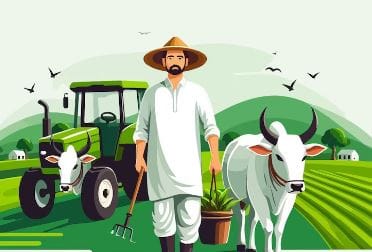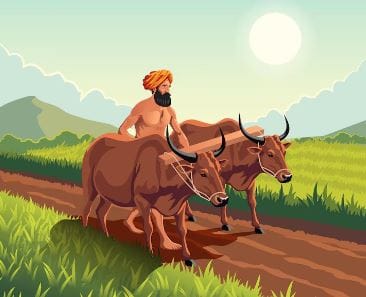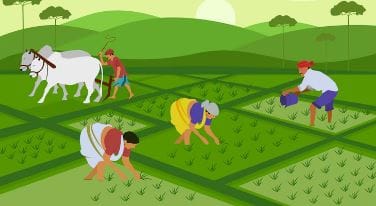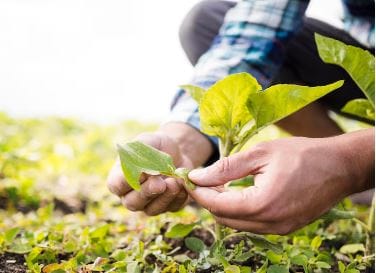The early morning in rural areas reveals itself to farmers who start their day early to care for food that nourishes human life. Farmer hands hold the secret to survival while their aged faces show the experience of dealing with natural changes and their hearts demonstrate complete resilience. The text examines the deep hardships which farmers experience although their difficulties frequently escape detection by those who depend on their agricultural work.

👉The Daily Battle: Life on the Edge :-
A young Indian farmer starts his journey to his agricultural fields during the nighttime darkness in a rural area. The established electricity schedule enables him to carry out crop watering specifically during the middle of the night. With his phone he uses the screen as a night light and time indicator during his nighttime field work in the wheat and horse gram fields. The cold winter season transforms his hands into numb pieces while he maintains constant effort to properly water his crops.
The reality described here represents a widespread problem that affects millions of farmers throughout the world. To determine night irrigation times the farmer studied water travel time in daytime light conditions so he could provide his crops with water during the dark hours. Farmers need to show resourcefulness daily so his creative approach serves as a model for others in their field.
At that fateful evening when he attempted to shift water towards his field his fingers became so cold and numb he lost his grip on the phone which fell into the water. His cell phone escaped his hands before dropping into the water. The instant loss of his phone resulted in the disappearance of months of earnings which dealt a severe financial blow to this man who depends on farming for survival.
According to Chris Bardenhagen who leads his Michigan orchard farm while being a sixth-generation farmer the gamble for his career future remains constant. The industry faces an uncertain future because “Is the industry going to pull out of this tailspin or not?”. The permanent uncertainty of agricultural life is explained through his words because success in this field rests on uncontrollable factors.
https://en.wikipedia.org/wiki/Agriculture_in_India
👉Economic Wise : Debt, Market Volatility & Exploitation :-
The Economic Vise Tightens Through Debt Combined With Market Instability And Taking Advantage Of Others
Agriculture no longer leads to improved financial situations for numerous farmers mostly found in developing nations but instead binds them as victims to debt. The severe drought in South India compelled thousands of farmers and laborers to take loans for survival while it led them into debt bondage and made them more prone to exploitation.
The situation drives people toward degrading work opportunities while trafficking operations spread wider. The situation has reached its highest danger point that cannot be ignored according to Gladston Xavier who tracks drought impacts in Tamil Nadu as a Loyola College professor.
A perpetual downward spiral exists when farmers take loans from moneylenders at high interest rates to buy seeds along with fertilizers and equipment. The farmers become unable to repay their loans because of unpredictable weather conditions and market price drops that destroy their crops. Each year many farmers continue borrowing additional funds which causes their financial situation to worsen.
Indian agricultural areas experience one of the most tragic contemporary trends as farmers fall into an endless cycle of debt because of which they choose to end their lives. Between 1997 and 2005 national records showed that Indian farmers took their lives at a rate of one every half hour and the statistics have continued to rise since that time. Vidarbha region in Maharashtra functions as the most tragic epicenter where this crisis manifests.

👉The Environmental Challenge: At Nature’s Mercy :-
A new level of difficulty exists for farmers across the world because of climate change. The agricultural areas of Marathwada India receive their water supply from rainfall because they lack sufficient irrigation systems. The unstable climate patterns from recent years have destroyed regional agriculture so that farmers now experience repeated losses of crops and bankruptcy.
The severe drought classified as an unprecedented drought cycle of recent times has struck the Indian states of Kerala, Karnataka, Tamil Nadu, and Andhra Pradesh. The combination of high temperatures and low reservoir water levels with minimal agricultural work opportunities creates severe problems for these villages. People in this situation must borrow money to obtain basic items including water and food together with other expenses such as medical care and education.
Bardenhagen from Michigan has reorganized his farm business operations at a basic level in order to survive. Bardenhagen explains that his farming operation required simplification for his safe transition into farm management while protecting his life from complete domination by the business. The farm operation exists now primarily as a high-density apple facility. The simplified operation costs Bardenhagen approximately $60,000 every year which forces him to work as a farm business management educator alongside taking loans from the Farm Service Agency financing program.
👉The Silent Epidemic: Mental Health Crisis Among Farmers :-
Agnomic distress reveals its deep impact upon humans. A mental health crisis among farmers emerged due to financial instability alongside physical seclusion and unpredictable crop yields caused by changing climate patterns which received public awareness recently.
The agricultural business operates in an increasingly unstable manner which produces large-scale anxiety problems particularly in farming populations that previously had minimal mental health support and continue to avoid help-seeking for psychological reasons.
Bardenhagen previously showed indifference to mental health matters yet he currently examines therapy as a means to handle the stress from running his family farm’s declining operations. He acknowledges the situation has become excessive since assuming control of his family business while he seeks financial backing and seeks profitable crops.
The acute mental health situation constitutes a fundamental yet underestimated element in the agricultural fight. The rural environment by itself together with financial instability and unpredictable farming conditions results in a complete mental breakdown. Farmers often endure their problems silently because the rest of the world cannot see their struggles unless they reach complete collapse.
👉The Widows’ Burden: Lives Shattered by Loss :-
The farmers who succumb to despair abandon their families with no other choice than to reconstruct their shattered lives. Young widow Phulabai Pawar of Gandhinagar settlement in Marathwada joins numerous widows who battle to support themselves after their husbands took their own lives.
Phulabai stands before a washing powder advertisement washing her dishes with ash while mourning her two-year widowhood of her late husband Nitin. The young boys Vishwas (6) and Ajay (4) stay at home to watch the damaged television while their mother sends no one to school.
She states that her parents and in-laws refused to take care of her children after her husband passed away. Before my husband passed away my older child attended a private school costing Rs. 10,000 per year for tuition. The younger boy attended an anganwadi as his educational institution. Since I must work outside the home daily I struggle to determine where my children should stay. Daily survival becomes a struggle since I barely secure enough money to feed my family. I cannot manage to pay the tuition fees so I am unable to send my children to school.
Her difficult choice to end her children’s schooling demonstrates how agricultural distress causes destructive chain reactions between different generations. Phulabai must face additional prejudice because she is a widow which creates extra challenges for her survival.
Journalist Kota Neelima documented widows of Vidarbha through her book “Widows of Vidarbha” by tracking families after their husbands and fathers took their lives by suicide during a multi-year research period. The long-term studies show agricultural distress triggers numerous waves of hardship which spread well past economic losses.
👉The Power of Collective Resistance: Farmers Fight Back :-
Farmers have proven their ability to group together and resist overwhelming obstacles. The Indian farmers’ protest of 2020-2021 stands as a testament to the power of collective action. The 13-month-long historic movement gathered support from every segment of working-class society as well as diverse sections of the population.
The participant in the movement declares that this struggle accomplished something deemed unthinkable by making an authoritarian government surrender to the main demands of the resistance. Hundreds of peasant organizations maintained their issue-based unity despite harsh repression alongside dangerous weather and pandemic circumstances and unceasing propaganda.
More than 700 farmers died during the protest which left an enormous cost on both sides. These sacrifices proved meaningful because the movement showed that combined strength defeats any adversary regardless of their powers.
The protest developed due to three farm acts which the government passed to extend agricultural corporatization and increase farmer market exposure. The combination of Bhartiya Kisan Union with All India Kisan Sabha and All India Trade Union Congress created a unified front that led to farmers’ interests prevailing despite government opposition.

👉Glimmers of Hope: Stories of Resilience and Transformation :-
In the midst of challenges people showcase outstanding strength and sometimes achieve remarkable achievements. John Smith who operates a farm through three farming generations continues to resist giving up despite unpredictable weather and market instabilities alongside restricted resources. The farmer asked assistance from members of his community and participated in workshops about sustainable farming as well as expanded his agricultural variety. John Smith applied drone technology to monitor his crops which resulted in turning his declining agricultural business into a thriving enterprise.
The correct guidance and support system in Kabirajpur village of Puri District Odisha helped Ranjan Nayak transition from an unsuccessful farmer into a prosperous entrepreneur. Farmers can overcome important obstacles with suitable support services according to the experiences demonstrated by his narrative.
The real-life achievements of farmers demonstrate the need for balance against statements about agricultural failure despite all the challenges faced by farmers today. The right mix of backing systems combined with innovative methods along with community unity indicates farming will stay sustainable and produce positive results.
👉The Path Forward: Recognizing Farmers’ Essential Role :-
Farmers face noticeable major system-related problems which need serious national attention. A broad set of factors caused by poor economic policies combined with limited rural support networks and inadequate infrastructure maintain agricultural distress conditions across Indian farming communities.
These difficulties reveal directions which may solve the problems. Farmers would become more resilient when rural communities have access to inexpensive credit and insurance coverage as well as psychiatric help. Being trained in climate adaptation together with following sustainable farming approaches will minimize environmental risks. Fair agricultural price mechanisms combined with proper compensation based on labor value would advance agricultural economics into a new direction.
Each meal contains stories that portray both fight and determination as well as optimistic visions. The hands that sustain global food systems need more than simple acknowledgment because they require active backing and promotional support. The success of farmers drives the well-being of every person in society even though our modern existence separates us from agricultural fields and farmers.
Our shared duty exists to support the ongoing battle of farmers. The hard hands of farmers protect our meal supply and guard both our natural soil and food system direction of the future. Real families who battle daily with dignity and determination stand behind statistics and policies asking for justice and the possibility to maintain their ancient vital work with dignity.

👉Measures to Support Farmers in Their Struggles :-
The challenges farmers experience consist of financial instability combined with environmental uncertainty as well as insufficient infrastructure and restricted market and technological opportunities. Caring for farmers requires a dual implementation of policy transformations together with financial backing along with technological advancement in farming and community advancement programs. The following strategies based on government programs and expert recommendations and sustainable development approaches will help farmers overcome their challenges and achieve better living conditions:
1. Direct Income Support and Financial Aid :-
⏩Pradhan Mantri Kisan Samman Nidhi (PM-KISAN) :- Through the PM-KISAN program farmers receive direct annual financial support worth ₹6,000 paid in three equal amounts for small-scale agricultural operations.
⏩Enhanced Credit Facilities :- It raise Kisan Credit Card (KCC) loan limits from ₹3 lakh to ₹5 lakh which makes short-term credit more accessible to farmers and fishermen and dairy farmers for obtaining agriculture equipment and inputs on time.
⏩Interest Subvention & Affordable Loans :- Through the Agriculture Infrastructure Fund farmers can access loans up to ₹2 crore with 3% annual interest subvention which decreases their investment expenses in community assets.
⏩Microloan Programs :- The program offers simplified microloan schemes which provide beginning and small-scale farmers with capital to improve their farms through loans up to $50,000 under US conditions while reducing bureaucratic procedures.
2. Price Support and Market Stability :-
⏩Minimum Support Price(MSP) & PM-AASHA :- The MSP system together with PM-AASHA guarantees farmers profitable prices for their outputs thus blocking sales under pressure and stabilizing their earnings.
⏩Formation of Farmers Producer Organizations :- The development of Farmers Producer Organizations (FPOs) provides small-scale farmers with combined bargaining power and resource sharing capabilities to gain access to technology platforms and enhanced market prices which builds their economic strength.
⏩Reducing Intermediaries & Improving Market Access :- The establishment of storage infrastructure and cold chain systems and farmers’ market platforms supports farmers to keep their profits by minimizing wastage and reducing middlemen involvement.
3. Infrastructure Development :-
⏩Agriculture Infrastructure Fund (AIF) :- Through the Agriculture Infrastructure Fund (AIF) government provides ₹1 lakh crore to finance medium- and long-term investments in post-harvest management infrastructure as well as irrigation storage and community farming assets which are essential for loss reduction and productivity growth.
⏩Rural Infrastructure Programs :- It facilitate land irrigation development and power delivery and road and transport system construction through PMGSY and DDUGJY schemes that improve rural market accessibility.
⏩Cold Storage & Processing Units :- Loans and subsidies for cold storage and processing units combined with wash and pack stations support small and mid-sized farmers to decrease spoilage and increase their product value.
4. Promotion of Sustainable and Modern Farming Techniques :-
Training in Sustainable Agriculture :- Through sustainable agriculture training people learn agroforestry, organic farming, permaculture and soil health management to obtain environmental sustainability and long-term soil productivity.
⏩Use of High Yielding & Climate Resilient Seeds :- National seed development programs through missions aim to provide farmers with high-yielding seed varieties that demonstrate climate resistance.
⏩Precision Agriculture & Technological Adoption :- Precision Agriculture combined with technological adoption of GPS devices and sensors as well as drone systems alongside advanced data analytic tools improves the way farmers use their resources while detecting crop conditions and promotes better performance with reduced expense.
⏩Subsidies on Fertilizers & Seeds :- Government subsidies for Fertilizers and Seeds lower their costs which makes it easier for farmers to obtain modern quality inputs for better crop production.
5. Risk Mitigation and Insurance :-
⏩Crop Insurance Schemes :- Through it government agencies provide protection to farmers by safeguarding them from natural disasters together with pests and market price changes which allows farmers to make safe investments in farming operations.
⏩Revised Subsidy Models :- New Subsidy Strategies Transition from offering direct subsidies of inputs like fertilizers and water and power to establish direct benefit payment methods for targeted funding and reduced waste.
6. Empowering Farmer Communities :-
⏩Support for Farmer Cooperatives & Youth Entrepreneurship :- The Yuva Sahakar scheme along with other programs supports farmer cooperatives by helping young people initiate or take charge of cooperative enterprises that bring innovative energy to agricultural practices.
⏩Community-Specific Programs :- It deliver programs that match local requirements to create efficient interventions such as the Millennium Villages Project.
⏩Social Security and Welfare :- These programs provide financial support with social benefits to small and marginalized groups of farmers together with widows and vulnerable members which improves both their well-being and quality of life.
7. The implementation of better markets together with enhanced value creation methods represents the key solution.
⏩Value Added Producer Grants :- It enable farmers to achieve higher income through product development while obtaining marketing skills and creating solid business plans for their agricultural products.
⏩Local & Regional Food System :-Through the Know Your Farmer Know Your Food initiative farmers gain access to local markets in conjunction with the development of regional food systems.
8. Mental Health and Social Support :-
⏩Mental Health Services :- It must address farmer mental health crises through counseling together with community support groups and awareness campaigns to protect their overall well-being as well as farm sustainability.
👉Conclusion: The Unbroken Spirit :-
Farmers worldwide maintain their life-sustaining work regardless of massive difficulties which include debt and climate change and mental health issues and institutional discrimination. These farmers display a resilience which directly contributes to human survival.
A quarter-century of political activism has never shown the scale of sustained popular support that endured over such a long victory-seeking campaign according to a farmer participating in the Indian protests. The triumph proved that collective action leads to victories which boost hope and strengthen belief in future group efforts.
Agricultural communities across the world maintain a hopeful spirit when they plant seeds and care for fields because this enduring determination has been the foundation of human agricultural existence since ancient times.
The viewing of their difficult circumstances requires not only sympathy but immediate steps toward helping our food providers and understanding the real expenses behind our meals and showing appreciation for the workers who grow and deliver our food. The ongoing battles of farmers create both our collective destiny and the shared economic advantage for our society.
💬Disclaimer :-
This Blog provides general information as an educational source only. The author uses their life experiences together with personal viewpoints to create all content. The author accepts no responsibility for damages or losses when users apply this information. The website information depends on your individual acceptance of personal risk when you use it. The information does not serve as professional guidance, so readers need to seek proper professional advice before implementing decisions from the provided content.